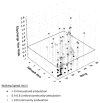Prediction of discharge walking ability from initial assessment in a stroke inpatient rehabilitation facility population
- PMID: 22446516
- PMCID: PMC5707123
- DOI: 10.1016/j.apmr.2012.02.029
Prediction of discharge walking ability from initial assessment in a stroke inpatient rehabilitation facility population
Abstract
Objectives: To (1) determine which clinical assessments at admission to an inpatient rehabilitation facility (IRF) most simply predict discharge walking ability, and (2) identify a clinical decision rule to differentiate household versus community ambulators at discharge from an IRF.
Design: Retrospective cohort study.
Setting: IRF.
Participants: Two samples of participants (n=110 and 159) admitted with stroke.
Interventions: A multiple regression determined which variables obtained at admission (age, time from stroke to assessment, Motricity Index, somatosensation, Modified Ashworth Scale, FIM, Berg Balance Scale, 10-m walk speed) could most simply predict discharge walking ability (10-m walk speed). A logistic regression determined the likelihood of a participant achieving household (<0.4m/s) versus community (≥0.4-0.8m/s; >0.8m/s) ambulation at the time of discharge. Validity of the results was evaluated on a second sample of participants.
Main outcome measure: Discharge 10-m walk speed.
Results: Admission Berg Balance Scale and FIM walk item scores explained most of the variance in discharge walk speed. The odds ratio of achieving only household ambulation at discharge was 20 (95% confidence interval [CI], 6-63) for sample 1 and 32 (95% CI, 10-96) for sample 2 when the combination of having a Berg Balance Scale score of ≤20 and a FIM walk item score of 1 or 2 was present.
Conclusions: A Berg Balance Scale score of ≤20 and a FIM walk item score of 1 or 2 at admission indicates that a person with stroke is highly likely to only achieve household ambulation speeds at discharge from an IRF.
Copyright © 2012 American Congress of Rehabilitation Medicine. Published by Elsevier Inc. All rights reserved.
Conflict of interest statement
No commercial party having a direct financial interest in the results of the research supporting this article has or will confer a benefit on the authors or on any organization with which the authors are associated.
Figures


References
-
- Quinn TJ, Paolucci S, Sunnerhagen KS, et al. Evidence-based stroke rehabilitation: an expanded guidance document from the European Stroke Organisation (ESO) guidelines for management of ischaemic stroke and transient ischaemic attack 2008. J Rehabil Med. 2009;41:99–111. - PubMed
-
- Bohannon RW. Rehabilitation goals of patients with hemiplegia. Int J Rehabil Res. 1988;11:181–3.
-
- Veerbeek JM, Van Wegen EE, Harmeling-Van der Wel BC, Kwakkel G. Is accurate prediction of gait in nonambulatory stroke patients possible within 72 hours poststroke? The EPOS study. Neurorehabil Neural Repair. 2011;25:268–74. - PubMed
-
- Sanchez-Blanco I, Ochoa-Sangrador C, Lopez-Munain L, Izquierdo-Sanchez M, Fermoso-Garcia J. Predictive model of functional independence in stroke patients admitted to a rehabilitation programme. Clin Rehabil. 1999;13:464–75. - PubMed
Publication types
MeSH terms
Grants and funding
LinkOut - more resources
Full Text Sources
Medical

